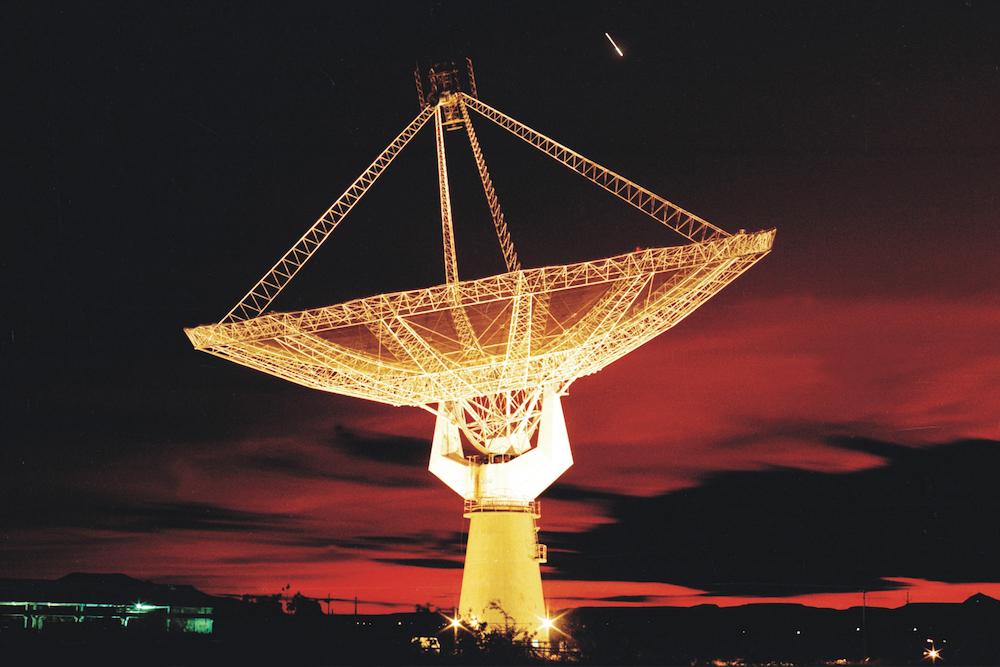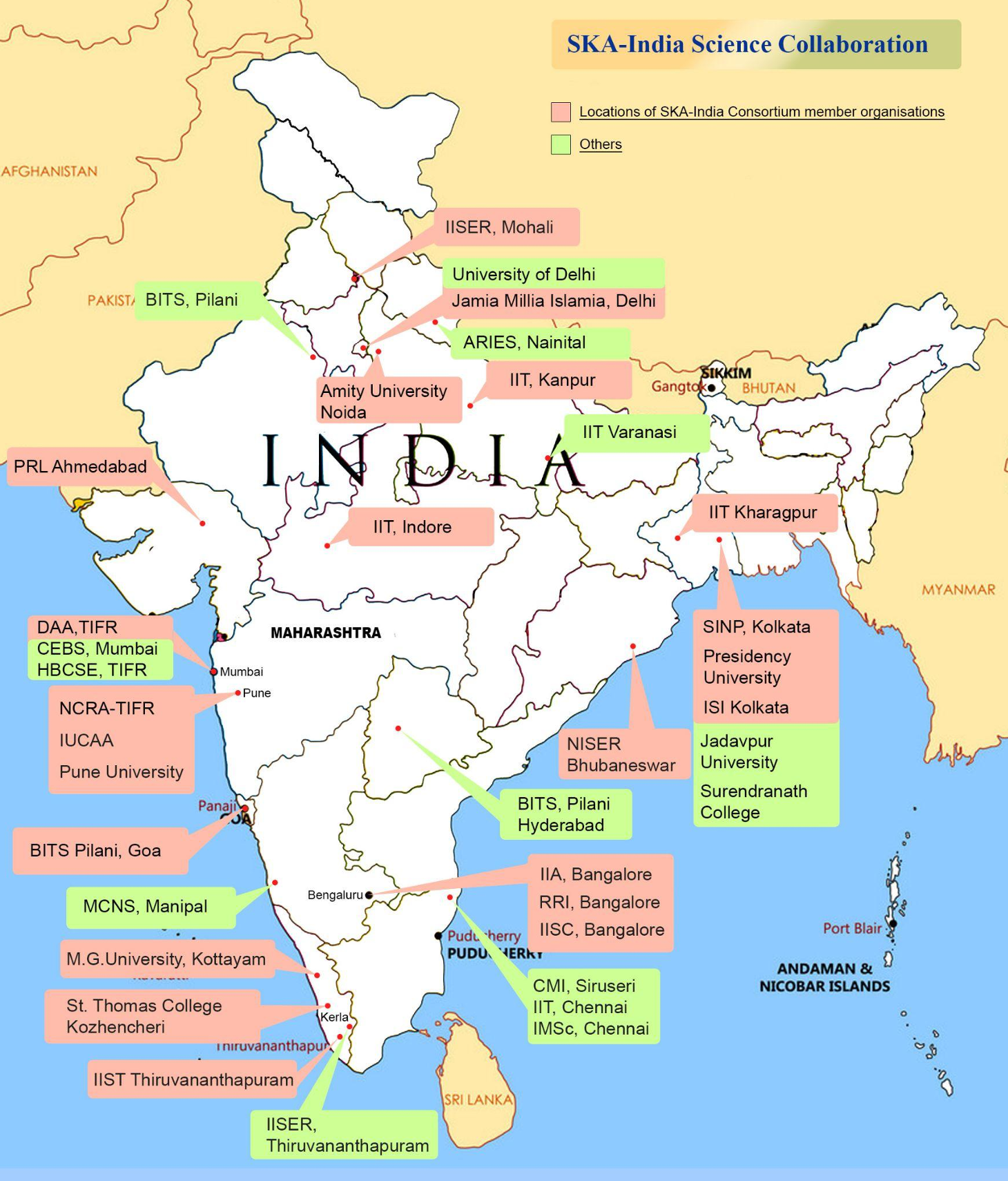India
At a glance
- India participated in three work packages during the design phase of the SKAO, with a lead role in the design of the Telescope Manager system.
- In the construction phase of the SKAO, India is aiming to contribute at a level close to about €100m.
- In addition to a major role in software work packages, India is playing a key role in the station-level digital signal processing hardware for the SKA-Low telescope.
- India is building up to have an SKA Regional Centre in India to host SKA data.
- Indian astronomers are gearing up to use the SKA telescopes for cutting edge science, and are represented in 12 of the 14 SKAO Science Working Groups with co-chair positions in three groups.
- The National Centre for Radio Astrophysics (NCRA) coordinates SKAO activities in India, with more than 20 institutions now part of the SKA India Consortium.
- India is home to an important SKA pathfinder facility – the Giant Metrewave Radio Telescope, which is one of the most sensitive low frequency telescopes in the world.
National involvement
India has played a pivotal role in shaping the Square Kilometre Array (SKA) project from its earliest days – refining the science case, driving technology development, and contributing significantly to the design and construction phases of the project. India, under the coordination of the National Centre for Radio Astrophysics (NCRA), led a seven member consortium for the design of the Telescope Manager system – a critical component of the SKA. India became a full member of the SKA Organisation in 2015 and was instrumental in the negotiations that established the SKAO as an intergovernmental organisation.
Strengthening its position further, India is aiming to contribute to the construction phase of the SKA at the level of around €100m, with significant contributions to the Observatory Management & Control software and the Science Data Processing software, as well as in the station-level digital signal processing hardware for the SKA-Low.
A good amount of synergy with the SKAO, both in terms of technology development and science drivers, comes from the Giant Metrewave Radio Telescope (GMRT), globally recognised as an SKA pathfinder facility operational in India. SKA-related efforts in the country are coordinated by the SKA-India Consortium, a network of over 20 leading institutions, uniting national expertise and resources in collaboration with industry partners. Together, these initiatives firmly anchor India at the heart of one of the world’s most ambitious scientific enterprises.

Industrial participation
Three major software companies – M/s Tata Consultancy Services, M/s Persistent Systems, and M/s Thoughtworks Technologies India – are the key contributors to India’s leading role in the development of the SKAO’s Observatory Management & Control system. Thoughtworks is also the lead company participating in the Science Data Processing software and the SRCNet development activities. Together, these work packages represent contributions worth €28mfrom India, delivered through the participation of seven SAFe teams from these companies.
For the delivery of signal processing hardware for the SKA-Low stations, five companies have been shortlisted to participate in the final tender for 2,500 ADU boards, with an estimated value of about €10m. Further, India is slated to contribute to other hardware and signal processing tasks that will involve additional industry participation.
In parallel, there are some direct procurements from Indian companies by the SKAO for some of the infrastructural items such as power cables. Overall, there is excellent and growing participation from Indian industry in the SKAO.
Science interests
Indian astronomers are deeply engaged in the SKAO’s scientific mission, with representation in 12 of the 14 Science Working Groups and leadership roles as co-chairs in Solar, Heliospheric & Ionospheric Physics, Pulsars, and HI Galaxy Science. They have also co-chaired other groups in the past and are contributing significantly to the upcoming science book Advancing Astrophysics with the Square Kilometre Array – II.
While waiting for the SKAO to come online, the Indian astronomy community has been actively using precursors and pathfinders such as the GMRT, MeerKAT and MWA for cutting edge science results in areas such as precision pulsar timing for detection of gravitational waves, and detection of HI high-redshift galaxies
At the national level, the community is organised into India-specific working groups that foster collaboration through regular online and in-person meetings. Annual workshops keep researchers informed of global SKA developments, while new initiatives aim to establish recurring SKA-India science meetings across the country. These efforts are creating a vibrant, well-connected community, ensuring Indian scientists remain at the forefront of SKA-driven discoveries.
Wider impact
India will host an SKAO Regional Centre (SRC), further strengthening its role in the global SKA ecosystem. Alongside this, India is making significant contributions to the design of the SRCNet system. Indian researchers have already built valuable expertise through their participation in recent SKAO Science Data Challenges, where teams with Indian members analysed mock datasets that simulate SKA observations.
Within the country, there are active PhD and postdoctoral programs in the SKA India Consortium member institutions, that will additionally be supported by SKA India funds. To build future capacity, the Consortium has also launched a dedicated training school for senior undergraduate and postgraduate students. Each year, 40 to 50 students will undergo intensive training in radio astronomy instrumentation, data analysis, and SKA-related science. The programme combines lectures with hands-on demonstrations and laboratory activities, equipping the next generation of researchers with the skills needed to exploit the unprecedented scientific opportunities of the SKA.
Public engagement has also been a priority. Through the Vigyan Samagam exhibition, the SKAO reached nearly 600,000 people across India, showcasing global mega-science initiatives and diverse career opportunities. This travelling exhibition visited four major cities, featuring lectures, panel discussions, interactive demonstrations, and extensive media coverage, significantly amplifying SKAO’s visibility and impact nationwide.

Contact
Email: skaindia@ncra.tifr.res.in





